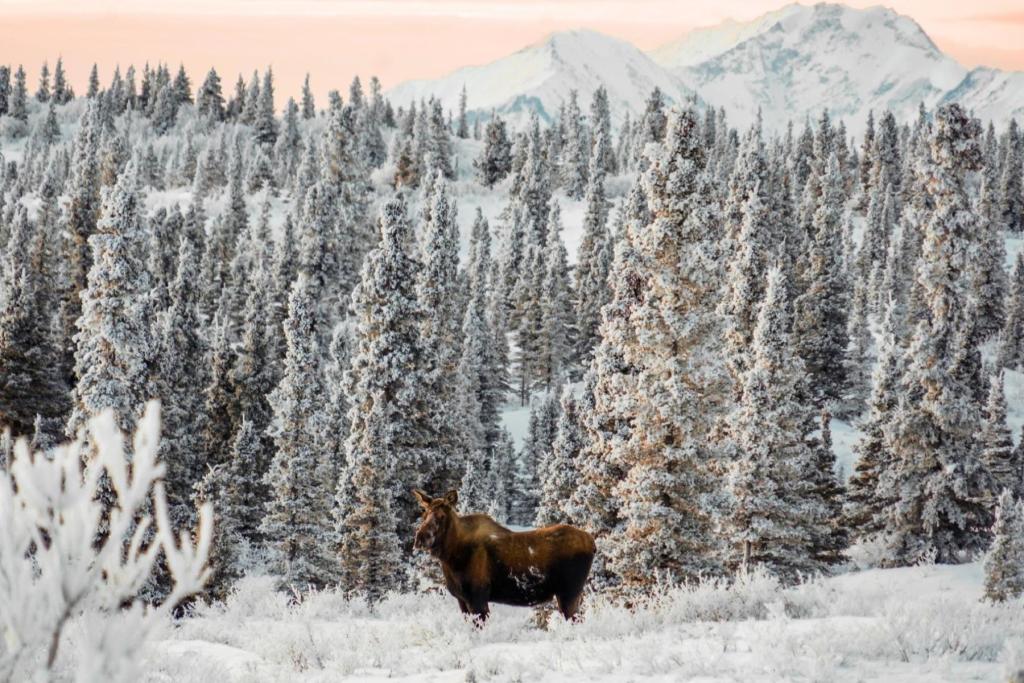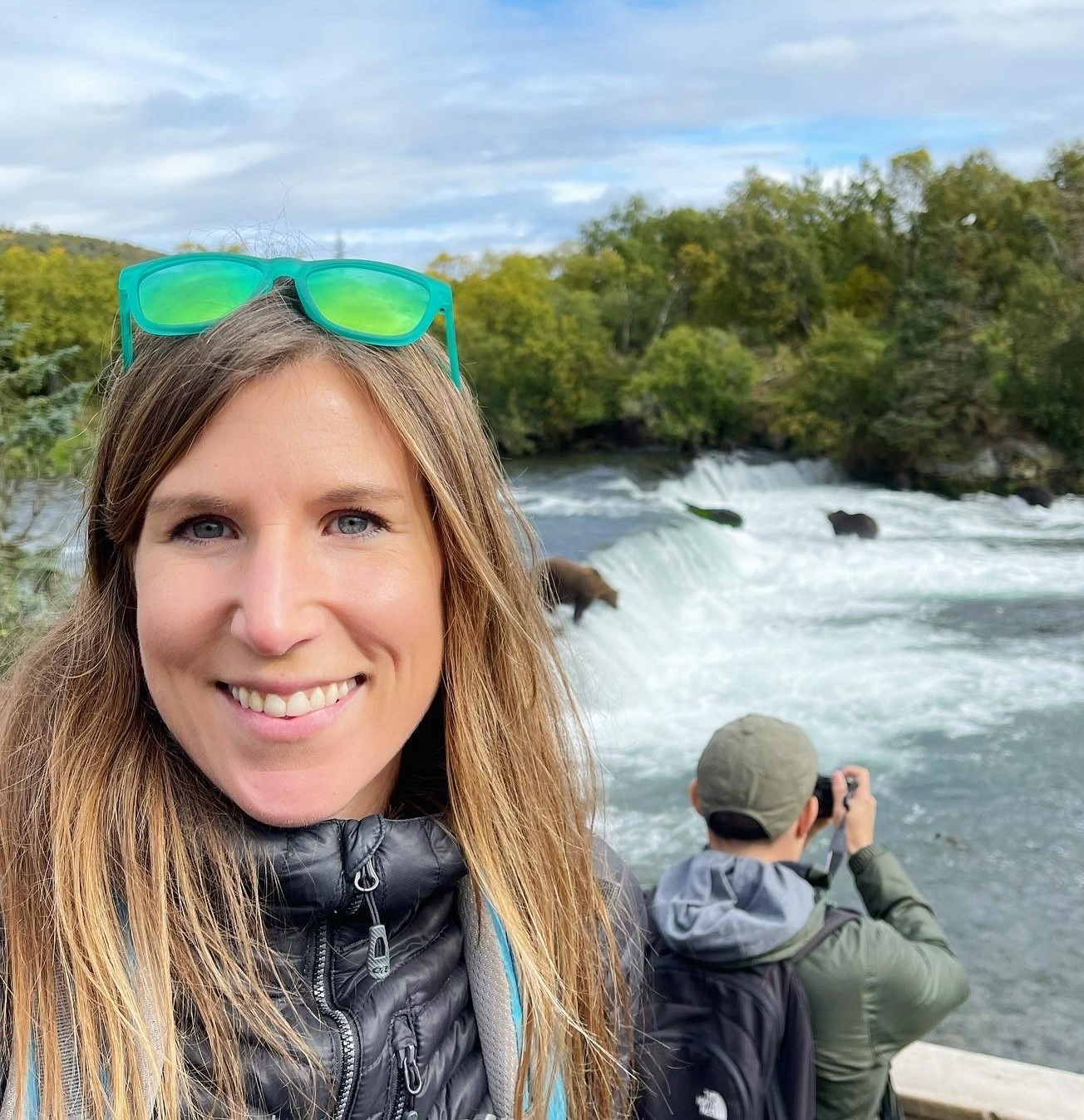Winter Wildlife Viewing in Alaska
Alaska is well-known for our incredible wildlife viewing in summer, but there are plenty of unique animal experiences to be had during our magical winter season. The cold, crips days and snow-covered mountains provide a stunning backdrop for viewing Alaska’s diverse land and marine animals. Listening to the crunch of moose hooves in snow and seeing the vast array of animal tracks on freshly-fallen powder makes for memorable wildlife experiences only available in winter. From witnessing wild animals in their natural habitats to up-close encounters at conservation centers and wildlife activities, here are the winter wildlife viewing experiences waiting for you in Alaska:
In the Wild
Alaska Land Mammals Viewable in Winter
Many species of land mammals are viewable in Alaska in the wild all winter long. Moose can be seen in every region of Alaska and are easier to spot in winter. They typically make their way down from the deeper snow in dense woods and higher elevations and can be seen closer to towns (and often right in town!) and at lower elevations. Their brown coat is easier to see against the white snow. Keep an eye out in towns and on trails and roads, particularly in the Southcentral and Interior regions – and you’re likely to see one of these majestic mammals munching on trees or bedded down in the snow.

Lynx, red foxes, wolves, coyotes, mink, marten, and wolverine can be seen statewide and are often easier to see against winter’s white backdrop, along with muskoxen in the Arctic, Sitka black tailed deer in the Inside Passage and Kodiak Island, and caribou, which can be seen in all regions except the Inside Passage. Harder to spot are Dall sheep and mountain goats, with white fur that camouflages them in winter.

Some land mammals have unique adaptations that makes their fur turn white in winter, including snowshoe hair, arctic foxes, and ermine. Sometimes the first thing you’ll see are their inquisitive eyes peering at you or their black-tipped ears or tails bobbing through the snow. Even if you can’t spot them, the snowy landscapes give you the inside scoop of who has traveled there before. Pay close attention to the ground after a fresh snowfall and you’ll see dozens of animal tracks criss-crossing the white landscape.
One species that you won’t see in Alaska in winter are bears. The state’s large populations of black and brown bears hibernate in the winter, typically going into hibernation in October and November and waking from their long slumber in March and April. If you’d like to see bears in Alaska, the best time to view them are June – September.
Alaska Marine Mammals Viewable in Winter
Alaska’s ocean and coastal habitats are rich with marine life, even in winter. Orcas can be seen in Alaska waters year-round, along with sea otters, Steller sea lions, and harbor seals. If you’re in one of Alaska’s coastal communities in winter, or if you’re out on a winter boat tour, kayaking tour, or fishing trip, keep an eye out in the water for sightings of these marine mammals. Gray whales also migrate through Alaska waters in March and April on their way from Baja to the Arctic and can be seen on early-season boat tours.

Alaska Birds Viewable in Winter
Alaska’s most majestic bird – the bald eagle – is viewable in Alaska year-round. In fact, one of the largest gatherings of eagles in Alaska can be seen at the Chilkat Bald Eagle Preserve outside of Haines from October through February, where thousands of eagles congregate to feed on salmon.

Other species like owls, woodpeckers, chickadees, nuthatches, jays, bohemian waxwings, redpolls, and more are easier to spot in winter. Alaska’s state bird, the willow ptarmigan, turn from a rich brown to bright white in winter – with just their black beaks and eyes and the sounds of their whooshing wings and clucking giving them away in the snowy landscape.

Wildlife Conservation Centers and Animal Experiences in Winter
For guaranteed up-close views of Alaska’s wildlife, visit one of the many incredible wildlife conservation centers and animal experiences that are open in winter.
Wildlife Conservation Centers
Alaska’s wildlife conservation centers are important rehabilitation and education centers that care for animals who have been injured or orphaned. Animals are released back into the wild if possible, and if they can’t be released, they are given enriching lives at the centers and serve as animal ambassadors to educate visitors on Alaska’s wildlife.
The Alaska Wildlife Conservation Center is located in Portage, about an hour south of Anchorage, with animals such as wolves, moose, caribou, muskox, lynx, foxes, eagles, and more viewable in winter (the resident black and brown bears will be hibernating). Further south in Seward is the Alaska SeaLife Center, a rehabilitation center for marine animals including seals, sea otters, Steller sea lions, and seabirds, many of which are viewable through underwater viewing areas. The Alaska Raptor Center in Sitka, housing eagles, owls, hawks, falcons, and more, is open in winter with reduced hours.

Wildlife Experiences
Winter wildlife experiences in Alaska give you up-close, sometimes interactive experiences with Alaska’s wildlife while learning about the important role that these animals play in local ecosystems and cultures. The Alaska Zoo, located in Anchorage, is a conservation and education-focused zoo housing Arctic and sub-Arctic animals. Heading north to Palmer, the Musk Ox Farm and Reindeer Farm are both open in winter and are family-friendly wildlife activities to enjoy year-round, set against the stunning mountain backdrop of the Mat-Su Valley.

In Fairbanks, pay a visit to Running Reindeer Ranch or Chena Outdoor Collective, where you can walk the snowy trails alongside a reindeer. The University of Alaska Fairbanks Large Animal Research Station houses herds of caribou, muskox, and other large animals for research and education and is open for limited tours in winter.

Whether you’re spotting animals in the wild, studying their tracks in the snow, or learning about Alaska’s wildlife at a conservation center or wildlife experience, be sure to add wildlife viewing to your next winter adventure in Alaska.
Alaska: AKA Your Next Adventure
Where will your Alaska adventure take you? Order our Official State of Alaska Vacation Planner and plot your course.


